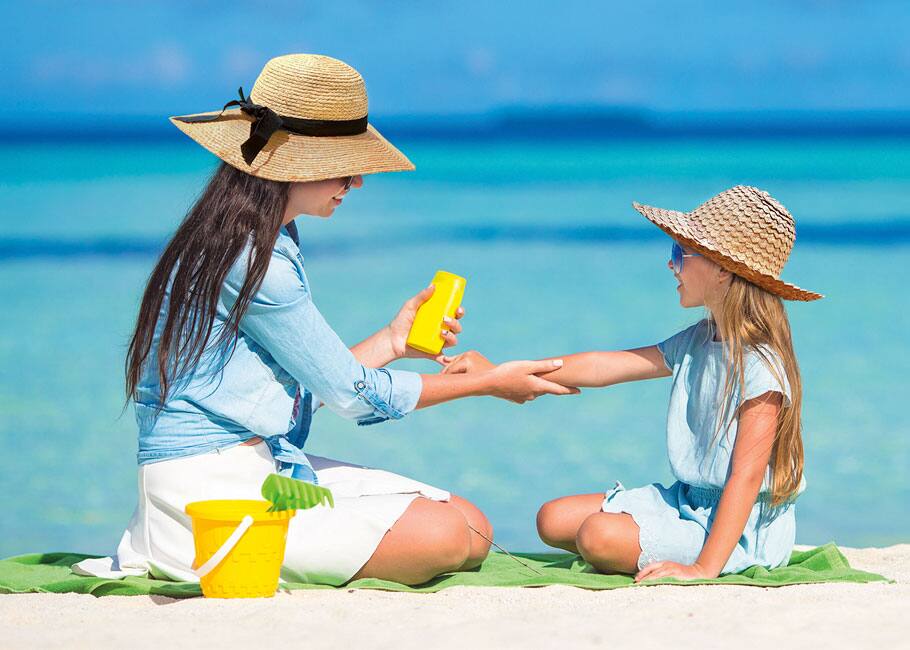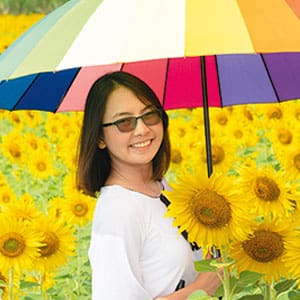
A ray of hope
Prevention, early detection help combat skin cancer
May is Melanoma and Skin Cancer Awareness Month, which shines a spotlight on one of the most common—and most preventable—cancers. Most skin cancer is caused by damage from the sun’s ultraviolet radiation (UV rays). Basal cell carcinoma is the most common form of skin cancer, affecting as many as 60,000 Canadians each year. Costco member Sandy Hargraves, an author in St. Andrews, New Brunswick, is among them.
In 2018, Hargraves noticed a quarter-sized, blister-like sore on her right shoulder that wouldn’t heal. After a dermatologist diagnosed basal cell carcinoma, Hargraves began regularly applying Aldara, a medicated cream that stimulated her immune system. Three months later, the sore had finally healed. Between then and 2021, five more basal cell carcinomas appeared—on her shoulders, forehead, chin and chest.
Hargraves, 57, expects to see more. “When I was young, no one talked about sunscreen,” she says. “We didn’t have the knowledge about skin cancer that we do now. Growing up, I played outdoors and lay out at the beach, and I tanned really well. I thought I looked better with a tan. We all feel pretty pasty in Canada after the winter, and our summer is so short, so you want to be in the sun as much as possible.”
Know the numbers
Costco member Dr. Cheryl Rosen has heard women say they think they look better with a tan, as well as thinner and sexier. The head of Toronto Western Hospital’s division of dermatology, and a professor in the University of Toronto’s department of medicine, warns that tanning poses serious, sometimes deadly, health risks.
“The incidence for melanoma, the most fatal form of skin cancer, is increasing,” says Rosen.
It’s important to note that anyone can get skin cancer. Melanoma develops in the cells that produce melanin, the pigment that gives skin its colour. According to the Canadian Cancer Society, if recent trends continue, 72% more new melanoma cases are expected to be diagnosed between 2028 and 2032 than were diagnosed between 2003 and 2007.
Better tools at hand
Thanks to developments in treatment over the last decade, patients with melanoma have a better chance of living longer.
Sunscreen formulations have also become more effective. “Canadian sunscreens have UVA-absorbing compounds that are not available in the U.S.,” says Rosen. “They are more effective because they do a better job at protecting against UVA damage.”
Addressing women who insist their face moisturizer with SPF 15 is adequate, Rosen says, “Moisturizers with sunscreen may not contain UVA-absorbing compounds, so they don’t offer broad-spectrum protection. And 15 isn’t a high enough sun protection factor. You need at least 30, and to apply it to all exposed skin. The risk of skin cancer far outweighs any possible chemical absorption.”
When Hargraves hit her 40s, she started wearing sunscreen when she noticed signs of sun damage showing up in people around her. Today, she wears SPF 60 on her face (a higher number turns her face red and blotchy) and SPF 110 everywhere else, dons a wide-brimmed hat and a lightweight, long-sleeved T-shirt, and stays in the shade when possible.
Hargraves and her husband, Ryan, are going on a Mediterranean cruise in June. “I plan to enjoy myself, but I’m going to be cautious of my sun exposure,” she says. “Now, when I see a woman who stays out of the sun, I notice that her skin is glowing. That should be our goal.”

© MIMIBUBU; PHOTO: VACHIRAPHAN / STOCK.ADOBE.COM
Sun safety tips
If Dr. Cheryl Rosen is going to be outside where there’s no shade, she takes her own: a parasol. “Sunscreen is an important part of sun safety, but so is shade and covering up,” she says. Sunglasses with 99% to 100% UVA and UVB absorption may help protect against eye melanomas.
When it comes to application, Rosen advises putting a bottle of sunscreen beside your toothbrush starting in April or May, and applying it in the morning after brushing your teeth, regardless of the forecast. And be practical; if your youngsters can’t wear a wide-brimmed hat to play sports, slap on a baseball cap and slather sunscreen on exposed skin.—JD
Are you at risk?
Costco member Sandy Hargraves’ fair complexion and blue eyes put her at a higher risk for skin cancer. She also has a family history of skin cancer. Other risk factors include:
- Blue or green eyes
- Blond or red hair
- Skin that burns, freckles, reddens easily or becomes painful in the sun
- Certain types and a large number of moles
- Older age—JD
Costco Connection: Sunscreen is available in Costco warehouses and at Costco.ca. Hats and protective clothing may also be available in spring and summer months.

